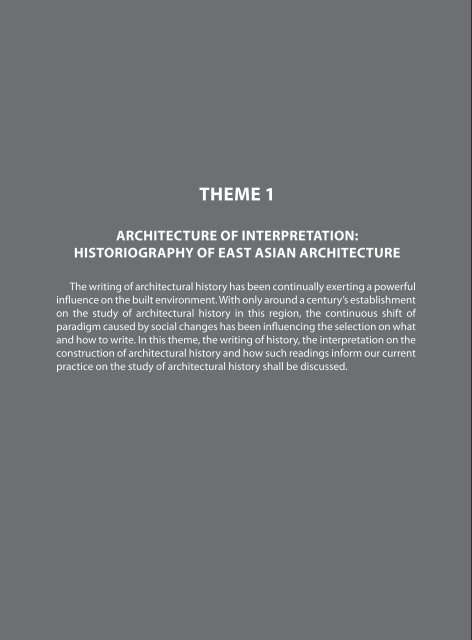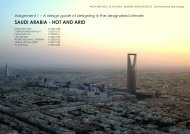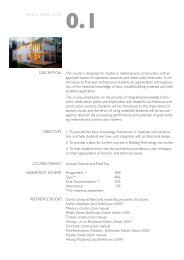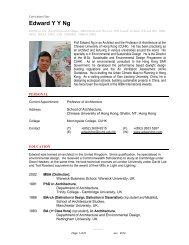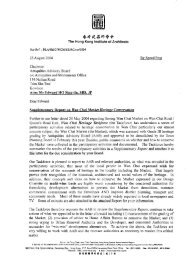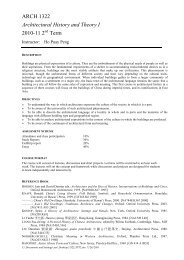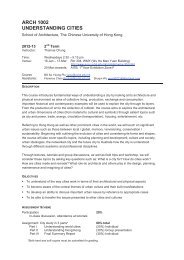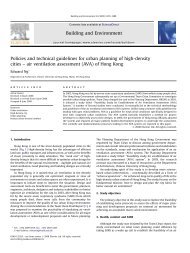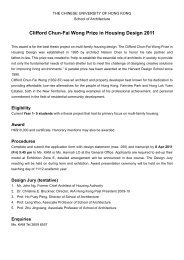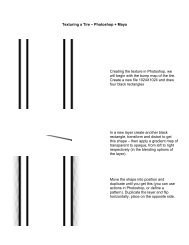CONVERGENCE in DIVERGENCE - School of Architecture - The ...
CONVERGENCE in DIVERGENCE - School of Architecture - The ...
CONVERGENCE in DIVERGENCE - School of Architecture - The ...
You also want an ePaper? Increase the reach of your titles
YUMPU automatically turns print PDFs into web optimized ePapers that Google loves.
2012 International Conference on East Asian Architectural Culture, Hong KongA New Study <strong>of</strong> the Modular System <strong>of</strong> the Ch<strong>in</strong>ese <strong>Architecture</strong>: Wooden Monuments<strong>in</strong> the Yuan Dynasties <strong>in</strong> Sichuan Prov<strong>in</strong>ceTHEME 1CAI Yu-kunABSTRACTResearch Associate , Chengdu Institute <strong>of</strong> Cultural Relics and Archaeology, Ch<strong>in</strong>aZHAO Yuan-xiangZHANG Yu Lecturer, Southwest Jiaotong University, Ch<strong>in</strong>aresearch assistant, Chengdu Institute <strong>of</strong> Cultural Relics andArchaeology, Ch<strong>in</strong>aModern researches argued a lot on whether the traditional Ch<strong>in</strong>ese wooden architecture has applieda certa<strong>in</strong> k<strong>in</strong>d <strong>of</strong> module system, and whether it matched the canons set by the 12th century architecturalmanual, Y<strong>in</strong>gza<strong>of</strong>ashi. This paper will come to its own judgment, based on some case studies <strong>of</strong> several13-or-14-century monuments <strong>in</strong> Sichuan Prov<strong>in</strong>ce <strong>of</strong> Southwest Ch<strong>in</strong>a.<strong>Architecture</strong> <strong>of</strong>InterpretationARCHITECTURE OF INTERPRETATION:HISTORIOGRAPHY OF EAST ASIAN ARCHITECTURE<strong>The</strong> writ<strong>in</strong>g <strong>of</strong> architectural history has been cont<strong>in</strong>ually exert<strong>in</strong>g a powerful<strong>in</strong>fluence on the built environment. With only around a century’s establishmenton the study <strong>of</strong> architectural history <strong>in</strong> this region, the cont<strong>in</strong>uous shift <strong>of</strong>paradigm caused by social changes has been <strong>in</strong>fluenc<strong>in</strong>g the selection on whatand how to write. In this theme, the writ<strong>in</strong>g <strong>of</strong> history, the <strong>in</strong>terpretation on theconstruction <strong>of</strong> architectural history and how such read<strong>in</strong>gs <strong>in</strong>form our currentpractice on the study <strong>of</strong> architectural history shall be discussed.This paper focuses on the Hall <strong>of</strong> Rotat<strong>in</strong>g Buddhist Scriptures ( 飞 轮 藏 殿 ) <strong>in</strong> J<strong>in</strong>xian Temple ( 金 仙 寺 ),<strong>in</strong> Pengxi County. This Hall, once be<strong>in</strong>g considered as a monument built no earlier than the 15th century,has newly been reconfirmed as a 1327-A.D.-built construction ( 泰 定 四 年 ). Under a careful survey <strong>of</strong> thiswooden build<strong>in</strong>g, we take different approaches to check the key dimensions <strong>of</strong> the build<strong>in</strong>g. As a result,a module system does exist <strong>in</strong> this build<strong>in</strong>g. Its value equals exactly the width <strong>of</strong> a s<strong>in</strong>gle modular unit orTsai ( 单 材 ) . That means, its module system is almost <strong>in</strong> accordance with the regulation <strong>in</strong> Y<strong>in</strong>gza<strong>of</strong>ashi (营 造 法 式 ).To make a broader and better understand<strong>in</strong>g <strong>of</strong> the module system <strong>in</strong> traditional Sichuan architecture,the Hall <strong>of</strong> Rotat<strong>in</strong>g Buddhist Scriptures <strong>in</strong> Yunyan Temple ( 云 岩 寺 转 轮 藏 殿 ) <strong>of</strong> Jiangyou County (built<strong>in</strong> 1181), and the Ma<strong>in</strong> Hall <strong>of</strong> Q<strong>in</strong>glong Temple ( 芦 山 青 龙 寺 大 殿 ) <strong>of</strong> Lushan County (built <strong>in</strong> early 14thcentury) are also <strong>in</strong>cluded <strong>in</strong> the scope <strong>of</strong> the discussion. Aim<strong>in</strong>g to obta<strong>in</strong> accurate survey data for thesebuild<strong>in</strong>gs, we are get ready to update and ref<strong>in</strong>e our conclusion if new progress were available.KEYWORDSSichuan, <strong>Architecture</strong> <strong>in</strong> Song and Yuan Dynasties, Module System, Y<strong>in</strong>gza<strong>of</strong>ashi ( 营 造 法 式 ), the Hall <strong>of</strong>Rotat<strong>in</strong>g Buddhist Scriptures ( 飞 轮 藏 殿 )19


